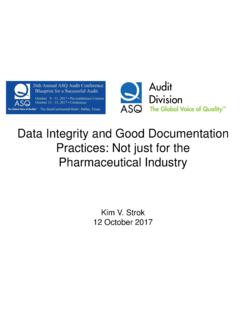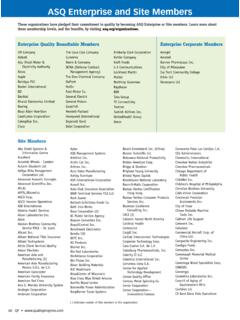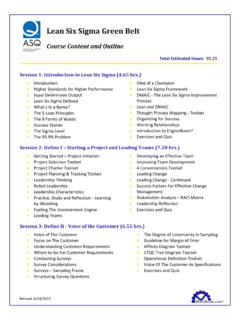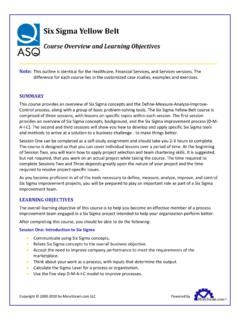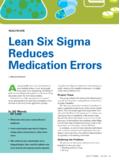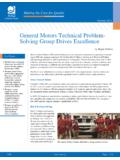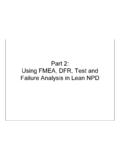Transcription of Metrics That Trigger Actionable Discussions: Prioritize ...
1 Metrics that Trigger Actionable Discussions: Prioritize Process Improvements Using Gauge R&R and SPC Capability by Govindarajan (Govind) Ramu If a typical process engineering review meeting at your organization involves engineers staring at scores of presentation slides and feeling overwhelmed, you may want to consider the Metrics you're using. High-level Metrics like throughput yield and scrap may seem like logical choices for regular product reviews, and they are useful at a business level; however, they tend not to Trigger Actionable improvement discussion . In contrast, the same powerful tools that engineers use in their everyday product development and process management applications can have enhanced benefits when put to work for broader decision making about improvements.
2 Integrating tools like failure mode and effects analysis (FMEA), gauge repeatability and reproducibility (GR&R), and statistical process control (SPC) provides a quality improvement framework that organizations can use to monitor process health, Prioritize improvements, and assign resources to actions that warrant most attention. Figure 1 shows how FMEA, GR&R, and SPC can be analyzed in the context of relationships between critical to quality (CTQ) and critical to process (CTP) parameters, leading to creation of a process health card. In eight steps, you can build your own process health card and begin using it at your engineering review meetings.
3 With your focus strongly on Metrics of practical interest to product and process engineers GR&R results, SPC stability status, and the potential risk to the organization of rejecting good parts or accepting bad parts (misclassification) which impacts the organization's cost of poor quality you should find it easier to engage in the Actionable discussions that the meeting should foster. Step 1: Identify CTQs and CTPs It is not unusual for the different product lines in any business unit's portfolio to have many quality characteristics in common and others that are entirely unique.
4 Defining and documenting quality characteristics for each product line is a crucial activity that should be the responsibility of cross- functional teams. First, assemble a team consisting of product line management; account management; and research and development, quality and manufacturing engineering, and customer representation. Where customer representation is not practical, the quality department, marketing, sales, or account manage- ment should provide support on behalf of the customer. This team is assigned with critical to quality (CTQ) characteristics identification.
5 For the same product line, assemble a second team for the purposes of critical to process parameter (CTP) identification related to the CTQs. Include manufacturing, quality, equipment, and production engineers, and invite R&D engineers where applicable. It is beneficial to maintain the team members of R&D, quality, and manufacturing engineering from the CTQ team in the CTP identification exercise. The team assigned with the task of identifying the critical to quality characteristics should use resources like voice of the customer tables, customer surveys, scorecards, market needs, engineer- ing specifications, and contracts to identify basic and perceived requirements and delighters for the product.
6 The team should further brainstorm any new expectations for the product. (This exercise will yield critical to quality characteristics that are both qualitative and quantitative, but this article focuses on the quantitative.). December 2007 I I 1. M e t r i c s T h a t T r i g g e r Ac t i o n a b l e D i sc us s i ons Figure 1. An Integrated Model for Quality Improvement This eight-step model begins with CTQ and CTP identification and leads to the creation of a process health card. Integrating tools like FMEA, GR&R, and SPC provides a quality improvement framework for monitoring process health, prioritizing improvements, and assigning resources.
7 Step Step Step 3 FMEA. F 6 S. SPC 5 GR&R. GR&. G. I d tif equipment Indentify e Establish Data query/retrieve severity, (real time, where possible). occurrence detection scales By process date? Plan GR&R. Validate data By lot sequence? experiment sequence By measure date? Indentify process steps to perform FMEA Control chart Measure GR&R. Measure Analyze data capability Cp/Cpk Indentify failure (if stable). OCAP database modes, causes, effects, current Identify controls, & risks special causes (if not stable) Cp, Cpk Yes Continue monitoring acceptable? stability and Identify critical process capability process variables Estimate process to monitor, performance indexes Step N.
8 No assign RPN. 7. Summarize the Cp, Cpk, Pp, Step Develop Ppk, GR&R%, Step 4 control plan (CTQ, CTP). false acceptance, false reject Prioritize improvement efforts 8. CTQ vs. CTP matrix CTQ. Step 1. 1 2 3. 1. CTP. 2 Date Alpha/ GRR/CL. Need Ne eed Drivers CTQs CTPs CTQ. Date CL Cp/ Cpk/ Beta Next due 1 2 3 3 GRR* GRR% EST. LCL UCL Stability** Pp Ppk Risk% date 1. CTP. Customer C t CTQ1 01/07 37% 01/07 20 24 NO 8/20 07/07. Needs 2. Customer Product Drivers I want .. 3 CTQ2 01/07 8% 01/07 YES 3/8 07/07. VOC. Product CTQ3 01/07 25% 01/07 15 18 NO 1/2 07/07. need CTQs CTP. Step Business Drivers CTQ CTP 2 CTP1 01/07 7% 01/07 200 208 YES 07/07.
9 Process Business CTQ CTP. CTP2 01/07 12% 01/07 YES 4/11 07/07. Needs CTQ. CTP CTP3 01/07 25% 01/07 NO 6/17 07/07. Primary Needs CTP Relationship CTQ. Secondary Needs Significant Moderate Weak CTQ. Tertiary Needs General Specific Hard to measure Easy to measure Screening DOE 80. Engineering Judgement 70. Relative good pieces throughput 60. 16 128 50. + 26 85 40. Process stage Benchmark Heat 30 Implementation New process 19 21 + 20. Cage 33. 34. 35. 36. 37. 38. 39. 40. 41. 42. 43. 44. 45. 46. 47. 8. 49. 50. 51. 2. *1. 2. 3. 4. 5. 6. *7. 8. 9. 10. 11. 12. 13. 14. 15. 16.. *5. *4.
10 17 25 Week * Data omitted for special cause Osculation +. December 2007 I I 2. M e t r i c s T h a t T r i g g e r Ac t i o n a b l e D i sc us s i ons Next, the team assigned with Figure 2. Need-CTP Tree Diagram CTP identification starts a brain- storming discussion . The inputs Need Drivers CTQs CTPs come from a combination of historical product knowledge, Customer experience with the product, Needs Customer quality tools like cause-and-effect Drivers diagrams, and statistical meth- I want .. VOC. ods like correlation and design of Product experiments. The output should CTQs be a set of CTPs for each CTQ.
